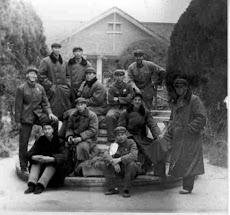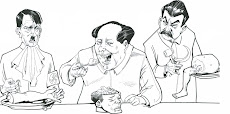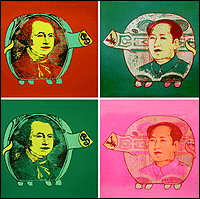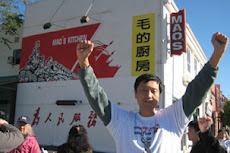
Turmoil in China 骚乱揭示了中国内政的腐败,无力与不稳定
陈凯一语:
新疆的表面族群争斗只暴露了中国政治文化的腐臭与政治架构的濒危。 中共党政的末日不远了。
The Turmoil in the Xinjiang region only reveals the rottenness of the Chinese political culture and the precarious position of the Chinese party-state. The end of the communist regime is near.
Turmoil in China 骚乱揭示了中国内政的腐败,无力与不稳定

上海“脆脆楼”的轰然倒塌寓示着整个中共党政从来就没有合法稳固的基础 Picture-perfect metaphor of Chinese society and governmental structure
By: Gregory Gethard
FrontPageMagazine.com | Thursday, July 09, 2009
The violent street battles that flared in China’s Xinjiang province this weekend, killing at least 156 people and injuring 828, represent only the latest eruption in the escalating tensions between China’s Han ethnic majority and its restive Muslim minority.
Xinjiang is located in China’s far northwest corner and its capital, Urumqi, lies 2,500 miles west of Beijing. Politically, too, the two regions are worlds apart, and the ongoing ethnic conflicts are a grim testament to China’s internal divide. Xinjiang is home to approximately 8 million Turkic-speaking Uighur Muslims, the biggest minority group in the area. But while the Uighurs comprise a large part of Xinjiang’s population, they represent only a tiny blip of China’s population of over 1 billion. Over 90 percent of the country is made up of the Han ethnic group, whose members primarily speak Chinese dialects. The weekend violence reveals the underlying conflict between these two groups and highlights the domestic fragility of a country that looks increasingly self-assured on the global stage.
In some ways, the tensions between the Han and the Uighur are a testament to China’s economic success. Due to China’s robust growth over the past decade, money has poured into regions like Xinjiang, drawing growing numbers of Han Chinese. According to the Guardian, there has been an large influx of Han in recent years. In 2000, for instance, over 40 percent of the province’s residents identified themselves as Han.
Times have been more difficult for the Uighur minority. Because of cultural and language barriers, many feel discriminated against when seeking jobs. The government is not especially sensitive to their plight. According to the BBC, no members of the Communist Party may worship in a mosque, and Islamic religious schools are heavily controlled by the state. The result, according to the BBC, is that there are fewer mosques in Xinjiang today than there were in 1949. Marginalized in their homeland, many Uighur’s are moving to China’s east in search of opportunity.
There in lie the roots of China’s culture clash. Last April, while most eyes were on the uprising in Tibet, Uighurs took to the streets to voice their displeasure with the government. Just last month, a group of Han Chinese murdered several Uighur workers at a facility in eastern China. This appears to have prompted the weekend protest in Urumqi. The rest is murky: some say the police fired on student protesters; the state-run media says the Uighur went on a rampage. And because of a tightly controlled media, and the region’s faraway location, there have been no independent accounts of what actually occurred.
One thing does seem evident, however: the most recent conflict between Uighur locals and the Chinese government has not stopped. Despite the deaths, injuries and arrests over the weekend, reports from the area note that the protests have continued. Not unlike last month’s uprisings in Iran, women have been taking the lead in their stance against the government, while Chinese authorities have tried to limit Internet and phone access to the region in order to put down the protests and blamed the violence on exiles like Uighur activist Rebiya Kadeer.
While the Uighurs’ have their just complaints, the Han Chinese do as well. For a time during the 1930s and 1940s, the Uighurs had their own homeland, dubbed the Islamic Republic of East Turkestan. When the Soviet Union’s collapse gave rise to new nations populated by Turkic-speaking Muslims, the Uighur’s feelings of nationalism – and separatism – reemerged. As a result, some have splintered off into a group known as the East Turkestan Islamic Movement. The Chinese government asserts that the East Turkestan Islamic Movement has been responsible for dozens of terrorist attacks since the 1990s, ranging from market bombings to prison uprisings to attacks on Chinese embassies abroad.
Chinese authorities also have alleged that the East Turkestan Islamic Movement has ties to al-Qaeda. Allegedly, Hasan Mahsum, the group’s founder and leader, was a protégé of Osama bin Laden, who offered his spiritual, logistical and financial support. Mashum denied these claims; however, in 2003, he was shot dead in an al-Qaeda training facility in Pakistan, indicating that perhaps this link was true. The Chinese government has also said that many of the group’s members have trained at al-Qaeda’s training camps, which were then based in Afghanistan.
The truth of such allegations remains difficult to determine, since many originate with China’s state-run media. But there is credible proof that the United States should have some concerns about the East Turkestan Islamic Movement. There is no doubt that many of its members were captured at al-Qaeda training bases after the invasion of Afghanistan. In addition, Kyrgyztan officials sent two East Turkestan Islamic Movement members back to China, claiming they were scouting out Western embassies in the city of Bishkek for a potential attack. U.S. forces also captured a group of Uighurs after the invasion of Afghanistan, ultimately releasing them to Albania, Bermuda and a tiny Pacific Island nation named Palau.
China has long been touted, not least by itself, as America’s successor as the world’s leading economic power. The still-simmering conflict between the Uighurs and the Han Chinese is a timely reminder that, for all its bluster, China remains internally unstable, with many of its domestic ills fueled by the very economic growth that the country sees as its key to superpower status.

































No comments:
Post a Comment